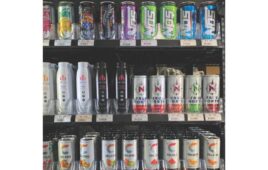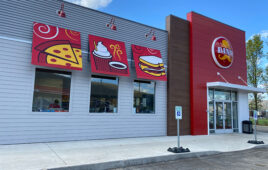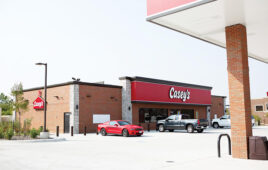Convenience store operators still not convinced foodservice is the future take heed. The National Restaurant Association (NRA) is predicting record-high sales of $580 billion in 2010. Furthermore, of the 70 different retail segments NRA tracks, the group identified convenience stores as the food industry’s “bright spot” when it comes to meeting consumer demand for fresh meal solutions.
“When you look at all household spending in the U.S., 49% is allocated toward restaurants,” said Hudson Riehle, NRA’s senior vice president of research and a co-author on NRA’s 2010 Restaurant Industry Forecast. “Convenience stores have become an important source for consumers purchasing fresh meals away from home. The segment will continue to grow the food industry overall and shift food dollars away from other segments this year and beyond. In short, convenience stores will be a bright spot in the foodservice umbrella in 2010.”
Riehle is forecasting a nearly 5% increase in the convenience store segment, which is nearly double the 2.5% jump forecasted for the food industry overall. By comparison, the quick-service restaurant (QSR) segment is projected to post sales of $164.8 billion in 2010, a gain of 3% over 2009. Sales at full-service restaurants are projected to reach $184.2 billion in 2010, an increase of 1.2% in current dollars over 2009.
“Convenience stores are getting much better at foodservice just as supermarkets have become more sophisticated over the years,” Riehle said. “What’s more important is that this is a different business than the rest of the store. Whether it’s economics or labor, a food operation needs to be managed more closely and benchmarked as concepts unfold. C-stores have done a good job understanding this.”
The trend of eating food outside the home continues to expand at an impressive clip. In 1955, for example, just 25% of consumers considered eating meals outside the family dining room.
The 49% identified by NRA not only reflects consumer confidence in foodservice retailers, but illustrates how pressed for time people are these days, which will further fuel the demand for fresh foods.
According to the NRA’s Industry Forecast, consumers will continue to seek value, convenience and expanded menu options in 2010. Consumers forced to cut back on spending said they aren’t dining out as often as they would like, but will quickly turn into restaurant customers as economic recovery continues.
In addition to convenience stores maturing as an industry, Riehle credited the channel’s larger distribution network and its keen ability to get products to market. “From a competitive standpoint, this has made convenience stores a much more viable competitor,” he said. “Look at the suppliers and their extensive distribution networks. They are much more robust than at any time and that has clearly benefited industry sales.”
Know Your Customers
One of the key points stressed by Riehle is that while trying to distinguish themselves from the herd, convenience store owners have become smarter and more willing to find a solution that works, rather than forcing a program onto customers—an idea that rarely works.
As consumer demand for fresh foods has grown, so too has the number of foodservice establishments, making it difficult to stand out with a unique offering. C-stores operators have embraced the numerous foodservice options available to them ranging from developing a proprietary food program, partnering with a well-know national or regional brand or contracting with a local supplier for daily third-party distribution. Determining which option is best depends on a number factors ranging from demographics, market competition and, ultimately, each chain’s level of commitment to the category.
While the restaurant industry’s projected 2.5% sales increase over 2009 is a relatively modest growth rate when compared to historical performances, these have not been ordinary times, Riehle said. The 2008-2009 timeframe was the most challenging period for the restaurant industry in decades.
“Given the state of the economy, the unemployment rate and all the other factors affecting consumers’ disposable income, we consider this growth to be monumental,” Riehle said. “Because of their good locations and ability to get customers in and out quickly, convenience stores are positioned to get a big share of sales going forward.”
NRA also reported that the decision to purchase a food solution is heavily dependent upon the occasion such as a traditional daypart meal or a late-afternoon pick-me-up. “With c-stores’ extensive network of locations and the consumers’ heightened need for food, there is a confluence of supply and demand that satisfies the consumer demand,” Riehle said.
Why Customers Are Eating Out
An NRA survey revealed that nearly four in five consumers believe going to restaurants with family or friends gives them opportunities to socialize and is a better way to use their leisure time instead of cooking and cleaning up. With nine in 10 adults saying they enjoy going to restaurants, the industry over the long term will continue along a path of growth.
Managing costs is important, but the extent of the industry’s upturn depends largely on consumer confidence, which is critical to long-term success. Unsteady job growth is expected to further challenge overall economic growth.
Until personal disposable income increases and unemployment levels fall, economic recovery is expected to be prolonged and patchy. While the economy shows signs of recovery, improvement isn’t expected until later in the year, said Riehle, who stressed the importance of these two factors on overall food sales. “There is no substitute for jobs. As employment picks up, household income rises and there is a greater need for convenience,” he added. “It’s a cyclical process with each factor affecting the other.”
To help spur consumer confidence, operators must take steps to provide value to guests. Smart operators will look to build sales by marketing healthful menu items and responding to consumer demand for convenience and variety.
Growth opportunities include delivery and other off-premise options, cooking classes and other interactive activities, and new media to reach new and returning guests.
“This year has its challenges, but the future is positive,” Riehle said. “Consumers forced to cut back on spending in the past two years continue to place a priority on dining out. Although they say they aren’t dining out as often as they like, they continue to patronize restaurants they believe offer value for their money. They also show interest in eating locally sourced food and seek an increasing array of ethnic cuisines.”
Consumers’ pent-up demand to dine out more often, combined with the myriad of consumer incentives, likely will nudge consumers into America’s 945,000 restaurants and help add steam to the nation’s economy.
NRA’s consumer survey also revealed opportunities for convenience stores to cater to specific customer needs. For example, the survey found:
• 65% of adults said their favorite restaurant foods provide flavor and taste sensations they can’t easily duplicate in their home kitchens.
• 40% of consumers said buying restaurant, take-out and delivery meals makes them more productive.
• 35% of adults don’t eat on-premises at restaurants as often as they would like on a weekly basis for reasons ranging from no value offerings to service takes too long.
Regional Outlook
Growth in the restaurant industry typically varies significantly by region of the country and is most heavily influenced by gains in employment, disposable income and population. In 2010, as the economy improves, some regions that were harder hit by the recession will see proportionally stronger recovery in restaurant sales.
NRA estimates that restaurant sales growth in the nine census regions in 2010 will range from a high of 2.6% in the Mid-Atlantic states to a low of 1.8% for the East North Central region.
In terms of state-by-state growth, Colorado is expected to post the strongest sales growth in 2010 at 2.9% (2010 industry sales of $8.7 billion), followed by Idaho at 2.8% ($1.6 billion). Forecasted to post growth of 2.7% are New Jersey ($12.8 billion), New York ($29 billion), North Carolina ($12.8 billion) and Texas ($34.8 billion).
Spotlight on Service
With sales numbers skewing toward convenience stores, the pressure is on operators to continue to raise the bar on their foodservice programs. After all, momentum can be fleeting without proper execution and an intense focus on consumer needs. The larger the chain, the more difficult the challenge.
Consider Tesoro Petroleum. Tesoro’s detailed retail marketing system includes more than 870 branded retail stations, of which more than 380 are company operated under the Tesoro, Shell, Mirastar and USA Gasoline fuel brands. Convenience stores are branded under the 2Go retail brand with locations throughout Hawaii, Alaska, California and Washington.
With so many stores in diverse markets, the retailer conducts extensive testing in its convenience stores to ensure its keeping customers satisfied.
“Our philosophy as a company is not to take big chances. We stick to the basics and provide a consistent offering that customers can count on,” said Greg Wingate, the foodservice category specialist and pricebook manager for Tesoro. “C-stores have struggled with consistency through the years, but if you look at the chains that do a great job with foodservice—QuikTrip, Sheetz, Wawa and 7-Eleven—they all have a quality offering that is consistent from one store to the next. That resonates with consumers.”
One area Tesoro has been focusing on is the morning daypart. The company is making a specific effort to solidify its coffee offering to meet the growing demand for fresh java. It partnered with Douwe Egberts, a product of Sara Lee, last year to develop a consistent offering. After test marketing the product in a number of its stores, Wingate said he would expand the rollout to larger volume stores.
The Douwe Egberts program is unique because it uses a liquid product that produces fresh coffee on demand. As a result, every cup is brewed fresh and the flavor is consistent from store to store. More importantly, it achieves Tesoro’s desired results with minimal labor.
“We benchmarked sales before and after and now have a positive coffee sales growth,” Wingate said. “We’re also seeing an increase in gross profit margin because there is no waste. “It gives us the consistent offering we need to compete effectively in this market.”
Simple and Significant
Sometimes the simplest tools are the ones you can’t live without. At Huck’s, the 125-store Carmi, Ill.-based convenience chain, Ken Pearson, vice president of foodservice, sees a lot of value in the stores’ cappuccino dispensers.
Most Huck’s stores offer eight flavors of cappuccino, all of them served from equipment that features touch-button controls and a touch-button hot water cleaning system. “Cappuccino is a strong draw that helps push hot food sales,” Pearson said.
Similarly, Jack Cushman, vice president of foodservice for Nice N Easy Grocery Shoppes in Canastota, N.Y., is experimenting with a grill that resembles a Panini press. “You can make a great grilled cheese sandwich on it, which is a very basic food,” he said.
Nice N Easy’s foodservice offering, however, is anything but basic. The chain offers an extensive line of hot and cold sandwiches and meal solutions around the clock.
“We don’t have a dedicated person, we have a dedicated staff,” Cushman said of the 86-store chain. “It comes down to economies of scale—volume cures a multitude of sins.”
And, at the end of the day, that’s what will determine whether a foodservice program is actually successful.
“We are in the foodservice business to be great. We expect nothing less,” Cushman said. “But that’s not something we just hope for. We work really hard at it every day. You can’t measure one unsatisfied customer in terms of one bad transaction. It has a ripple effect. So the goal is to never have an unsatisfied customer. You do that with great food, a great staff, listening to what your customers want and exceeding their expectations. It’s not easy, but when you do it consistently, you’re rewarded with a stream of repeat business.”
That attitude, according to Riehle, is why c-stores are an emerging force. “The majority of all restaurant sales end up local, so c-stores will continue to grow as an important foodservice provider,” he said. “There may have been a time when the industry wasn’t taken seriously, but I’m sure they have everyone’s attention now.” CSD




